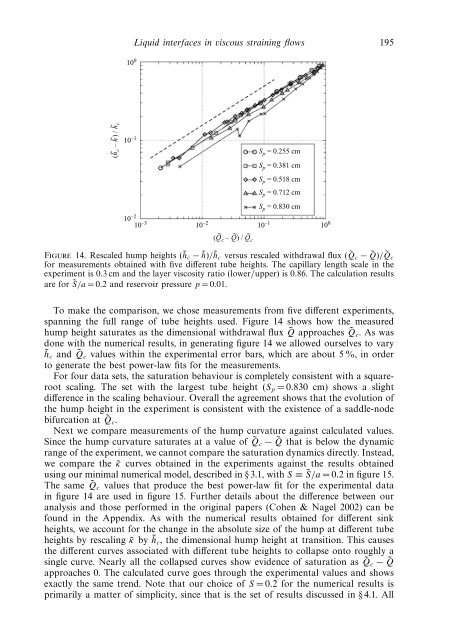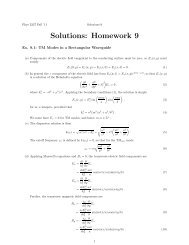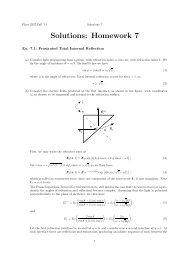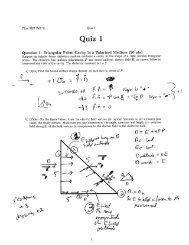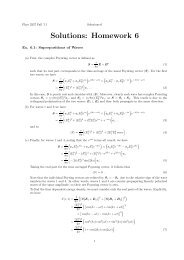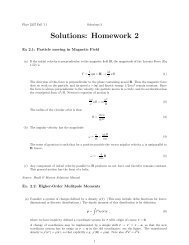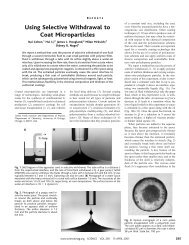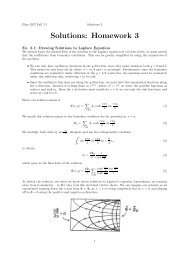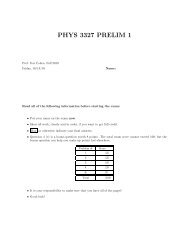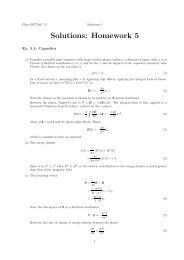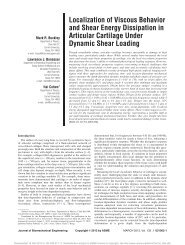Liquid interfaces in viscous straining flows ... - Itai Cohen Group
Liquid interfaces in viscous straining flows ... - Itai Cohen Group
Liquid interfaces in viscous straining flows ... - Itai Cohen Group
You also want an ePaper? Increase the reach of your titles
YUMPU automatically turns print PDFs into web optimized ePapers that Google loves.
10 0<strong>Liquid</strong> <strong><strong>in</strong>terfaces</strong> <strong>in</strong> <strong>viscous</strong> stra<strong>in</strong><strong>in</strong>g <strong>flows</strong> 195(h ~ c – h~ ) / h ~ c10 –1S p = 0.255 cmS p = 0.381 cmS p = 0.518 cmS p = 0.712 cmS p = 0.830 cm10 –2 10 –3 10 –2 (Q ~ c – Q~ ) / Q ~ c10 –1 10 0Figure 14. Rescaled hump heights (˜h c − ˜h)/˜h c versus rescaled withdrawal flux ( ˜Q c − ˜Q)/ ˜Q cfor measurements obta<strong>in</strong>ed with five different tube heights. The capillary length scale <strong>in</strong> theexperiment is 0.3 cm and the layer viscosity ratio (lower/upper) is 0.86. The calculation resultsare for ˜S/a =0.2 and reservoir pressure p =0.01.To make the comparison, we chose measurements from five different experiments,spann<strong>in</strong>g the full range of tube heights used. Figure 14 shows how the measuredhump height saturates as the dimensional withdrawal flux ˜Q approaches ˜Q c .Aswasdone with the numerical results, <strong>in</strong> generat<strong>in</strong>g figure 14 we allowed ourselves to vary˜h c and ˜Q c values with<strong>in</strong> the experimental error bars, which are about 5 %, <strong>in</strong> orderto generate the best power-law fits for the measurements.For four data sets, the saturation behaviour is completely consistent with a squarerootscal<strong>in</strong>g. The set with the largest tube height (S p =0.830 cm) shows a slightdifference <strong>in</strong> the scal<strong>in</strong>g behaviour. Overall the agreement shows that the evolution ofthe hump height <strong>in</strong> the experiment is consistent with the existence of a saddle-nodebifurcation at ˜Q c .Next we compare measurements of the hump curvature aga<strong>in</strong>st calculated values.S<strong>in</strong>ce the hump curvature saturates at a value of ˜Q c − ˜Q that is below the dynamicrange of the experiment, we cannot compare the saturation dynamics directly. Instead,we compare the ˜κ curves obta<strong>in</strong>ed <strong>in</strong> the experiments aga<strong>in</strong>st the results obta<strong>in</strong>edus<strong>in</strong>g our m<strong>in</strong>imal numerical model, described <strong>in</strong> § 3.1, with S ≡ ˜S/a =0.2 <strong>in</strong> figure 15.The same ˜Q c values that produce the best power-law fit for the experimental data<strong>in</strong> figure 14 are used <strong>in</strong> figure 15. Further details about the difference between ouranalysis and those performed <strong>in</strong> the orig<strong>in</strong>al papers (<strong>Cohen</strong> & Nagel 2002) can befound <strong>in</strong> the Appendix. As with the numerical results obta<strong>in</strong>ed for different s<strong>in</strong>kheights, we account for the change <strong>in</strong> the absolute size of the hump at different tubeheights by rescal<strong>in</strong>g ˜κ by ˜h c , the dimensional hump height at transition. This causesthe different curves associated with different tube heights to collapse onto roughly as<strong>in</strong>gle curve. Nearly all the collapsed curves show evidence of saturation as ˜Q c − ˜Qapproaches 0. The calculated curve goes through the experimental values and showsexactly the same trend. Note that our choice of S =0.2 for the numerical results isprimarily a matter of simplicity, s<strong>in</strong>ce that is the set of results discussed <strong>in</strong> § 4.1. All


